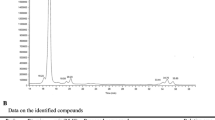Abstract.
The formation of ascorbigen (ABG), one of the major indole-derived compound of Brassica vegetables, has been studied. An HPLC method developed previously in our laboratory was used to determine ABG precursors, glucobrassicin (GB) and L-ascorbic acid (AA), in intact plant tissues of four nutritionally important vegetable crops belonging to the genus Brassica – white cabbage, cauliflower, Chinese cabbage, and broccoli. The levels of GB varied within the range 25–142 mg kg–1 and AA contents varied within the range 110–840 mg kg–1. The amounts of ABG in homogenized Brassica vegetables was found to be between 7 mg kg–1 and 18 mg kg–1. The level of GB in the plant material was shown to be the limiting factor in the process of ABG formation. Calculated conversion values expressing the conversion of GB into ABG revealed that only 20–46% of GB present in intact plant tissues was employed in the process of ABG formation. The conversion values increased with decreasing pH values of the vegetable homogenates.
Similar content being viewed by others
Author information
Authors and Affiliations
Additional information
Revised version: 11 October 2000
Electronic Publication
Rights and permissions
About this article
Cite this article
Hrncirik, K., Valusek, J. & Velisek, J. Investigation of ascorbigen as a breakdown product of glucobrassicin autolysis in Brassica vegetables. Eur Food Res Technol 212, 576–581 (2001). https://doi.org/10.1007/s002170100291
Received:
Issue Date:
DOI: https://doi.org/10.1007/s002170100291




